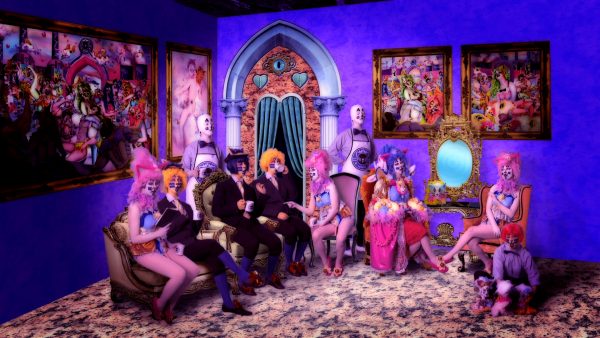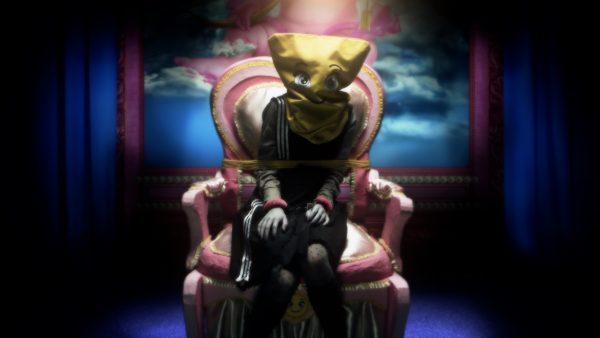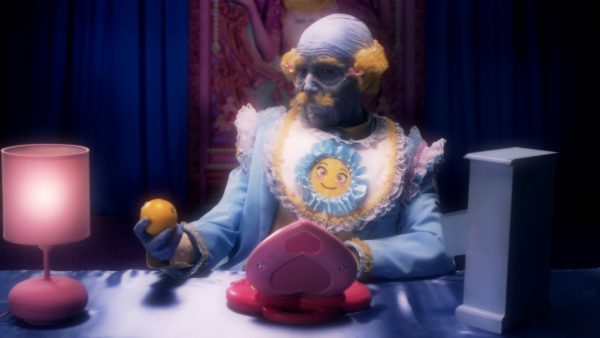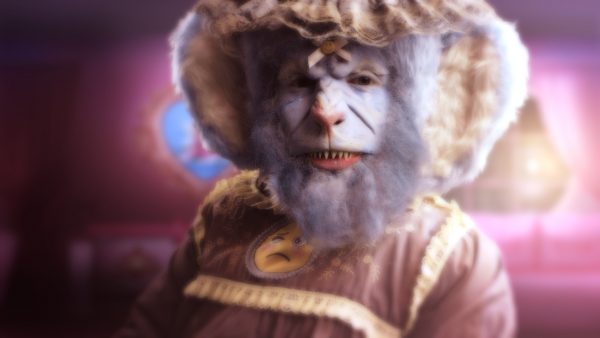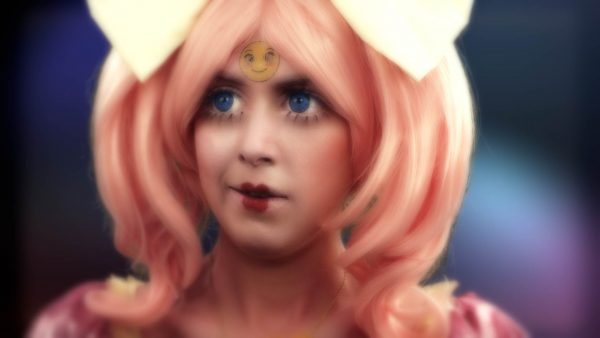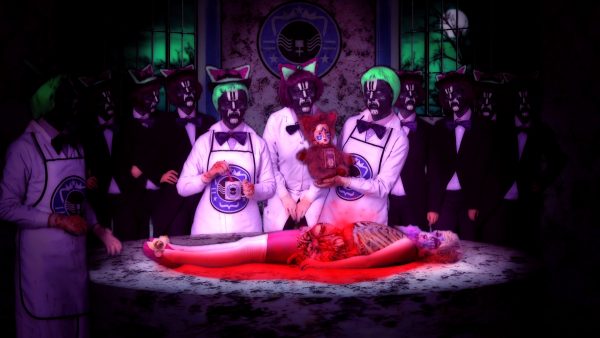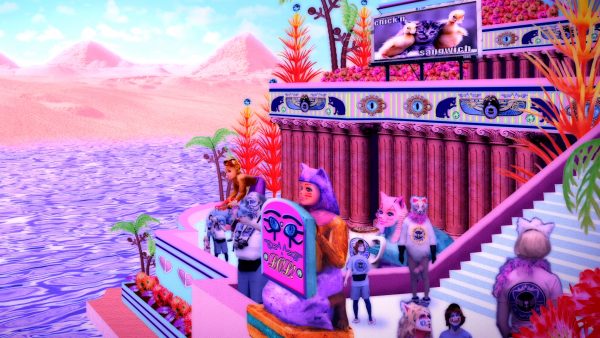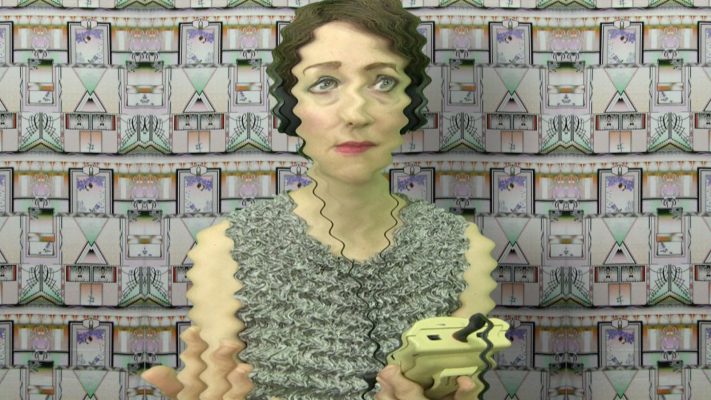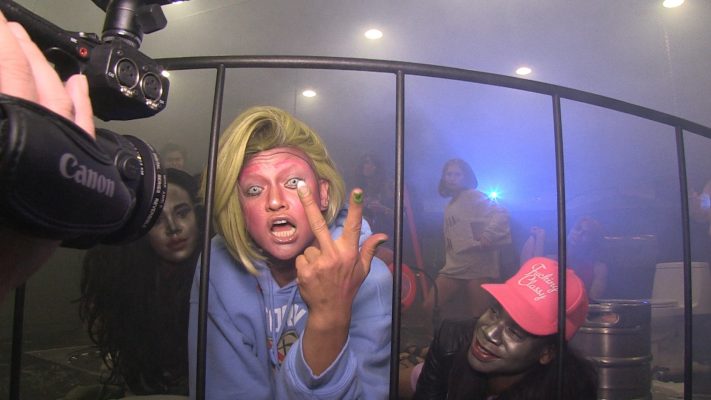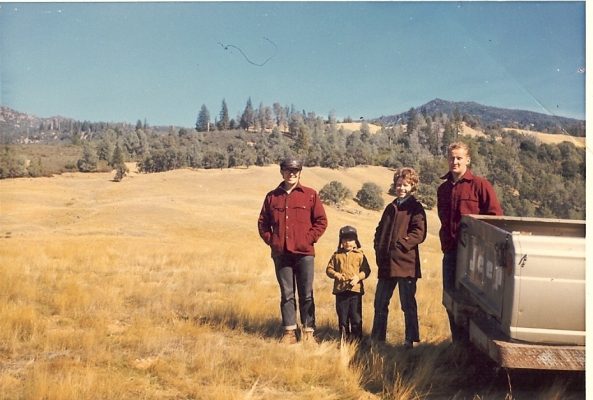Rachel Maclean’s films are startlingly new and disturbingly familiar. Splicing fairy tales with reality television shows, tabloid stories, Disney films and Internet memes, the Glasgow-based video artist’s satirical fantasy narratives are held together by a bizarre yet persuasive dream logic. We go through the looking glass and into nightmarish pop culture wonderlands, digitally rendered in a pulsating medley of lurid pink, purple, yellow and blue: a fluorescent, feline-themed kingdom inhabited by cat-people with high heels and big rubber breasts in LolCats (2012); a post-apocalyptic burning planet where the few remaining humans squabble over their nation status in A Whole New World (2013). Often accompanied by found sound – sources range from an interview with Katy Perry to a speech by David Cameron – these worlds are at once nothing and much like our own.
Feed Me (2015), currently on show as part of the British Art Show, is Maclean’s longest and most ambitious work to date. Installed in a room resembling a tween bedroom – which adds the cloying smell of cheap carpet to the already intense viewing experience – it depicts a seedy dystopian city where a sinister toy corporation uses invasive online marketing tactics to peddle plastic ‘happiness’ to the masses. Characters range from a voyeuristic, pot-bellied business executive to a schoolgirl social media addict, all played by Maclean. Using Green Screen technology, she has populated the film with legions of cloned versions of herself, laboriously filled in the background with layer upon layer of hyper-saturated computer graphics, and overdubbed the dialogue with the voices of professional actors. Maclean is in fact the sole performer in all of her works – and is just one among a number of recent contemporary moving image artists using performance, personae, avatars and alter egos to hold a mirror up to society and to question identity in today’s post-social media age.
Citing the photographer Cindy Sherman as inspiration, Maclean uses makeup, clothes and her own body to impersonate figures male and female, young and old, animal and human. While Sherman recreates recognisable feminine archetypes from film and art history, making portraits that look almost ‘real’, yet subtly wrong, Maclean’s characters are truly outlandish. To give you an idea: the business executive in Feed Me wears a suit and a baby bib, has a padded stomach, painted blue skin, and Irn-Bru orange hair. Sharing a taste for the grotesque with artist-filmmakers such as Matthew Barney, Mike Kelly and Paul McCarthy, her creatures look more like clowns or figures from a terrifying children’s TV programme than real-life people.
One of the most disturbing features of Maclean’s characters is the fact that the face paint, wigs, faux-historical costumes and Lolita dresses used to construct their physical appearances are not made for the purpose, but in fact sourced either from Poundland or online cosplay retailers. These monsters may look alien but in fact already exist, in various disassembled forms, in our collective cultural imagination. Maclean uses these absurd chimeric creations to exaggerate and destabilise stereotypes reproduced in the media and pop culture: pop star bimbos; ‘hoodies’; patriotic Scots; paedophile monsters.
While Maclean works with multiple characters and across a range of personae, Ed Atkins and Shana Moulton employ single alternative identities to work through aspects of their own personalities and explore wider social issues. For the past few years, Atkins has been ‘performing’ via digital avatars that take the place of his own body. The multi-channel video installation Ribbons (2014), shown at the Serpentine Sackler Gallery in 2014, features an avatar called Dave who delivers a long, disjointed monologue, occasionally breaking into melancholy song. Dave, who Atkins describes as ‘a surrogate and a vessel’, has the generic physical appearance of a white, shaven-headed man. Atkins has mapped his own features onto him and given him his voice, leading the viewer to question where the artist ends and the avatar begins. Dave is by turns insecure and pretentious, an extreme version – the viewer is led to assume– of the artist who created him.
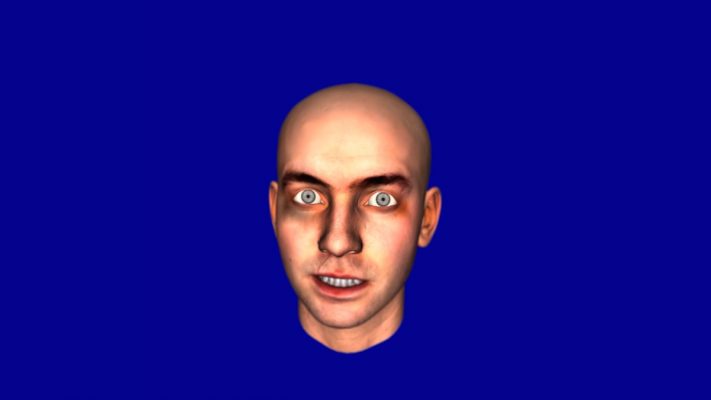
Moulton works with an alter ego rather than an avatar. Recalling the work of feminist artist Lynne Hershman Neeson, who famously created a fictional persona named Roberta Breitmore, Moulton has created an alternative persona called Cynthia – a naive hypochondriac with confidence issues. In Whispering Pines (2002-ongoing), a long term video series and performance project, Cynthia gets through life as best she can with the help of prescription drugs, beauty products, exercise and spirituality. The series is partly inspired by Twin Peaks, and Moulton overlays her films with digital graphics to create a distinctive magic-realist, pastel-coloured New Age aesthetic. In a similar vein to Atkins, the New-York-based artist has stated that she uses Cynthia as a means of working through her own neurotic tendencies, as well as to highlight the anxieties rife in contemporary culture.
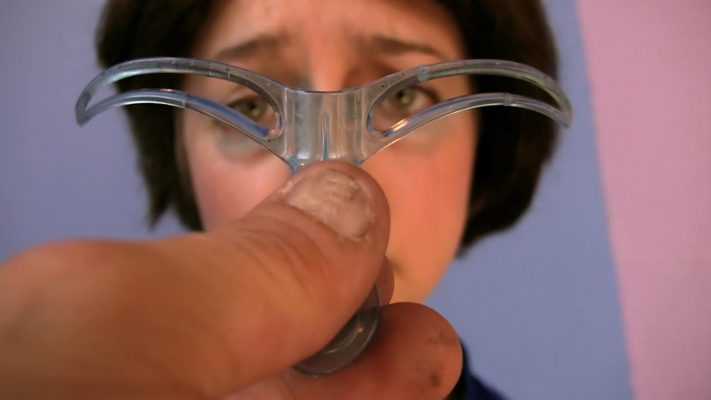
In Feed Me, Maclean addresses the hypocrisies underlying broader contemporary social anxieties over paedophilia, online grooming, personal privacy, and so-called gang culture. She presents an infantilised world in which corporations harvest personal data so that they can more effectively stir up insatiable desires in adults and children alike. They then ‘feed’ those desires with computer games, medications and bottle-feeding dolls (the true weirdness of these real-life toys is horribly exposed here). It’s never quite clear who we are to treat as the victims and who the villains, as characters slip from one position to the other. The perspective switches constantly: screens opening within screens, on computers, phones, toys, cameras. Everyone is gazing at everyone else, as the musical interlude ‘Watching Me Watching You’ drives home. You get the claustrophobic sense that the film will chase itself round in circles forever.
Mainstream media distinctions between ‘good’ and ‘evil’ are broken down in Feed Me. Innocent girls are prey for child-molesting beasts (the tabloid monster made literal), but they are also drug dealers and murderous cannibals. Predatory sex offenders are also big, outcast babies, lonely, hungry and misunderstood. Though they take on pre-existing class and gender caricatures, these characters constantly undermine them, the performative nature of social roles underlined by the fact that all parts are played by a 28-year-old white woman. The upshot is a fantasy world driven by the same paradoxes at the heart of our consumer capitalist society: child abusers are vilified by a society in which young girls are increasingly sexualised; happiness is imperative, but entirely commoditised; youth is fetishised but also feared. It’s the palpable sense of rage, as much as the inimitable aesthetic, which makes Maclean’s work so exciting.
Much as Maclean reconstructs the world in exaggerated, surreal proportions in order to critique it, Ryan Trecartin’s hyperactive, disorientating films refigure a familiar way of living. In his video work the LA-based artist, his friends, and professional actors play attention-seeking characters of ambiguous gender – composites of Instagram feeds and narcissistic Facebook pages – who babble incessantly to the hand-held camera. Their monologues are a mix of sass and jargon – consisting of phrases copied and pasted from various corners of the Internet which seem occasionally to chime with some existential truth. With their jumpy cuts, hectic music and needy characters talking at a hundred miles an hour but rarely making sense, the films are like an accelerated version of reality TV programmes or vlogs. Tacky graphics chase over the screen, like pop-up ads or new browser tabs.
Events unfold chaotically, linked by no discernable narrative thread. Instead the focus is on the performances, which can be read as embodied enactments of identity crises. Center Jenny (2013), for instance, revolves around a group of characters – several of them called Jenny. These characters are all attempting to emulate an archetypal Jenny, who has somehow evolved to a superior state of being. It’s impossible to work out what’s going on – yet, disconcertingly, you get the sense you’ve seen it all before. Trecartin’s films look and sound like living in a post-social-media society feels.
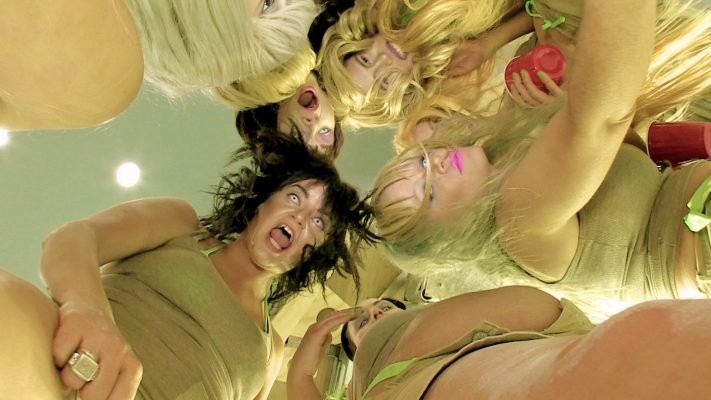
The four artists I’ve discussed here are all blurring the boundaries between performance, video, and digital art. But beyond their formal and stylistic similarities, what connects them is the fact that their work is so deeply engaged with issues of gender, identity, consumerism and alienation in society today. The British Art Show, of which Maclean is a part, has as its theme ‘The Capacity of Things’, with a focus on rediscovering materiality in a digital age. The exhibition is ostensibly concerned with the present, yet a thread of nostalgia for the past runs through it – nostalgia for the skills, objects, and human connections that we’ve lost. In contrast, the work of Maclean, Trecartin, Atkins and Moulton feels decidedly rooted in the here and now. This might seem counterintuitive, as they shell off their ‘real’ selves and take on avatars and alter egos, eschewing documentary realism. Yet their fantasy realms encourage us to look, from new and skewed perspectives, at the world in which we live.
